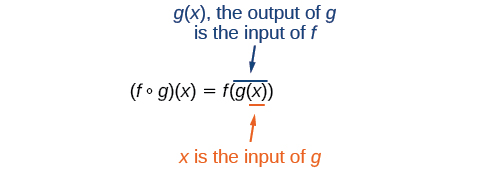| << Chapter < Page | Chapter >> Page > |
Find and simplify the functions and given and Are they the same function?
Begin by writing the general form, and then substitute the given functions.
No, the functions are not the same.
Note: For the condition is necessary because when the denominator is equal to 0, which makes the function undefined.
Find and simplify the functions and
Are they the same function?
No, the functions are not the same.
Performing algebraic operations on functions combines them into a new function, but we can also create functions by composing functions. When we wanted to compute a heating cost from a day of the year, we created a new function that takes a day as input and yields a cost as output. The process of combining functions so that the output of one function becomes the input of another is known as a composition of functions . The resulting function is known as a composite function . We represent this combination by the following notation:
We read the left-hand side as composed with at and the right-hand side as of of The two sides of the equation have the same mathematical meaning and are equal. The open circle symbol is called the composition operator. We use this operator mainly when we wish to emphasize the relationship between the functions themselves without referring to any particular input value. Composition is a binary operation that takes two functions and forms a new function, much as addition or multiplication takes two numbers and gives a new number. However, it is important not to confuse function composition with multiplication because, as we learned above, in most cases
It is also important to understand the order of operations in evaluating a composite function. We follow the usual convention with parentheses by starting with the innermost parentheses first, and then working to the outside. In the equation above, the function takes the input first and yields an output Then the function takes as an input and yields an output

In general, and are different functions. In other words, in many cases for all We will also see that sometimes two functions can be composed only in one specific order.
For example, if and then
but
These expressions are not equal for all values of so the two functions are not equal. It is irrelevant that the expressions happen to be equal for the single input value
Note that the range of the inside function (the first function to be evaluated) needs to be within the domain of the outside function. Less formally, the composition has to make sense in terms of inputs and outputs.

Notification Switch
Would you like to follow the 'College algebra' conversation and receive update notifications?